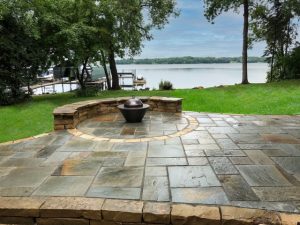Nothing makes your home landscape look more beautiful than a luscious lawn in a red summer sunset. The summer heat, however, can be enough to wreak havoc on the health and appearance of your lawn. While the trees and plants on your property grow lusciously with plenty of sun exposure and proper watering, the grass in your lawn is susceptible to a number of hazards. Overexposure to the sun’s heat without proper watering or care will cause it to dry up and die before fall. On the flipside of the coin, grass that does not receive enough exposure to sunlight due to shading from thick tree canopies will also begin to thin right around midsummer. Consider planting a species of shade grass this summer for a full lawn all season long.
How Can You Make Your Lawn Last All Summer With Shade Grass?
Common Solutions
Most people jump to three common solutions for treating dehydrated, or strained lawns. The first is the use of shade seed mixes, or hydroseeding. These mixes contain added nutrients that help promote growth and protect grass and seedlings from disease. The second is the use of ground covers for shade by way of annuals, perennials, ornamental grasses, and moss. Mulching the area around your trees is also a common solution to maintaining shaded species. Using mulch or ground cover plants helps to stimulate the nutritional value of the soil, which in-turn promotes healthy lawn growth.
Shade Grass Species
An alternative to using any of the three solutions mentioned above is to use a species of shade grass. These species’ can more easily grow in the presence of shade than other common species. There are two primary species that work well in northern climates, and one that is more practical for warmer climates.
Colder Climate Species:
1. Supina bluegrass (Poa supina) – this species is native to the Alpine region. It is capable of growing in heavily shaded areas with moist soil. When mixed with other shade grass species, like rough bluegrass (Poa trivialis), the mixture will produce a thick canopy in shaded areas that would otherwise fade after a short time. You should, however, consider several factors before you go this route, including expenses (this species costs about $25/pound), and coloration (this species may contrast with other grasses in your lawn)
2. Creeping red fescue (Festuca rubra) – there are over 200 named varieties of Festuca rubra. This species has been used in many different grass mixtures throughout the years, and works to provide a ‘carpet’ that not only helps the grass, but also overcomes the bunching appearance that is common with fescue species of grass. Although this species is ideal for northern climates, it is not as tolerant of cold weather as other species.
Warmer Climate Species:
1. St. Augustine grass (Stenotaphrum secundatum) – this species is used in warmer climate regions like the southern and central US states, and in California. Although this species is not ideal for cooler, northern climates, like ours here in Twin Cities, MN, St. Augustine grass is considered one of the more shade tolerant species.
In short, the best way to get full-bodied grass around your trees and shaded areas is by using a mix with a variety of species. These various species should compliment each other in terms of growth rate, color, texture, tolerance to weather and foot traffic, and seasonal performance.

